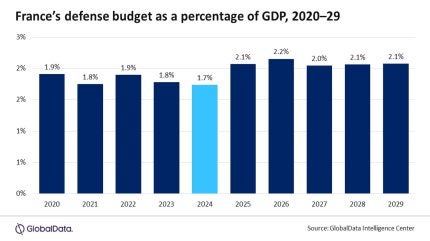
The defence spending of France is projected to rise from $60.4bn in 2024 to $67.8bn by 2029, according to a recent report by GlobalData.
In July 2023, France announced its defence spending plans for the next six years through Military Planning Law (LPM) for 2024-30.
This plan builds on the modernisation initiatives initiated by the previous LPM (2019-25) to address evolving geostrategic dynamics and enhance the integration of emerging technologies, including uncrewed and space-based systems.
The report titled “France Defense Market Size, Trends, Budget Allocation, Regulations, Acquisitions, Competitive Landscape and Forecast to 2029” indicates that France’s defence budget will grow to $64bn by 2025.
This growth is attributed to domestic modernisation programmes, the impact of the Russian invasion of Ukraine, and commitments to the NATO alliance.
GlobalData senior defence analyst Tristan Sauer said: “The deterioration of European security following Russia’s invasion of Ukraine has highlighted the importance of France’s strategic reforms, providing the impetus for further and more diversified investment in defence and security capabilities.
“The most recent spending commitments will allow French defence expenditures to surpass 2% of GDP and finally attain the minimum threshold recommended for NATO members.”
France’s Military Planning Law for 2024-30 expects ongoing growth in defence spending to support modernisation across all branches of the armed forces.
This includes a focus on new domains like space and cyberspace, as well as the integration of emerging technologies.
Investments are being directed towards various market segments, including fixed-wing aircraft, missiles and missile defence systems, naval vessels, submarines, and armoured vehicles.
The FCAS New Generation Fighter programme, SNLE 3G nuclear submarines, and Rafale fighter jet upgrades are among the largest planned expenditures.
Despite the increase in defence spending, France is struggling with recruitment challenges that have led to personnel shortages.
Between 2025 and 2029, France is expected to spend $125.9bn on military personnel, with the spending growth rate at a modest CAGR of 0.5%, compared to the 1.26% CAGR from 2020 to 2024.
Sauer concludes: “France’s continued investments in modernization and acquisition programs provide substance to the broader political refocus on strategic competition and its associated risks, with the nation’s growing defence industrial base providing growing opportunities for international engagement. However, much like with the US and other NATO allies, lacklustre performance with regards to personnel recruitment and retention is indicative of a wider challenge, which current investments have thus far failed to overcome.”



